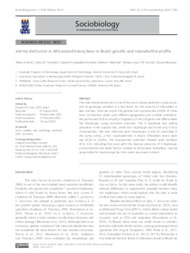Varroa destructor in Africanized honey bees in Brazil: genetic and reproductive profile.
Varroa destructor in Africanized honey bees in Brazil: genetic and reproductive profile.
Autoria: PINTO, F. A.; TEIXEIRA, E. W.; GUIMARÃES-CESTARO, L.; MARTINS, M. F.; ALVES, M. L. T. M. F.; MESSAGE, D.
Resumo: The mite Varroa destructor is one of the most studied parasites in apiculture, and its genotype variation is a key factor for the severity of infestation in bee colonies. Here we report the genetic and reproductive profile of mites from 14 Brazilian states with different geographic and climatic conditions. We performed PCR to amplify a fragment of the COI gene and differentiate the haplotypes using restriction enzymes. The K haplotype was widely prevalent in the studied sites, while the J haplotype was found only in four municipalities. We also observed both haplotypes (J and K) coexisting in the same colony, a fact unprecedented in Brazil. Infestation levels were low (0.33 to 15.3%). The reproductive potential showed wide variation (0 to 1.5), indicating that even with the massive presence of K haplotype, environmental and biotic factors related to Africanized honeybees may be responsible for maintaining the mite under low levels in Brazil.
Ano de publicação: 2022
Tipo de publicação: Artigo de periódico
Unidade: Embrapa Gado de Leite
Palavras-chave: Abelha Africana, Acari, Apidae, Parasita, Patologia, Perfil genético, Perfil reprodutivo
Observações
1 - Por padrão são exibidas publicações dos últimos 20 anos. Para encontrar publicações mais antigas, configure o filtro ano de publicação, colocando o ano a partir do qual você deseja encontrar publicações. O filtro está na coluna da esquerda na busca acima.
2 - Para ler algumas publicações da Embrapa (apenas as que estão em formato ePub), é necessário ter, no celular ou computador, um desses softwares gratuitos. Sistemas Android: Google Play Livros; IOS: iBooks; Windows e Linux: software Calibre.
Acesse outras publicações
Acesse a Base de Dados da Pesquisa Agropecuária (BDPA) para consultar o acervo completo das bibliotecas da Embrapa.

